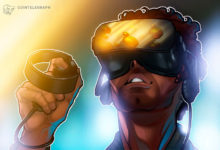How Will NFTs Affect The Future Success Of The Metaverse?

The NFT craze has taken the world by storm. Artists, actors, musicians, sports personalities, and even global brands are jumping onto the NFT bandwagon.
As the underlying technology continues to evolve, NFTs have come far from being called “overly expensive JPEGs” to emerge as a promising digital asset class that is gradually redefining the existing models of socialization, user interaction, and gamification.
NFTs have found a niche market via the emergence of Play-to-Earn (P2E) blockchain games. As the next logical step in its expansion, NFTs are increasingly being applied to Metaverse applications.
Crypto proponents are rallying behind the idea that NFTs will be the bridge to the Metaverse and beyond, given that the metaverse comprises thousands of elements. For instance, in the popular Metaverse game The Sandbox, NFTs represent individual players and virtual lands, properties, and other digital real estate that form Sandbox’s ecosystem. Another example would be the newly launched Alpha V2 of the P2E Metaverse game MixMob.
Built by a skilled team with years of experience across leading game titles like Halo, FIFA, Battlefield, and Pokerstars, among others, MixMob uses NFTs to showcase its games’ lore and storytelling while facilitating user-generated content (UGC) and unlocking monetization opportunities. Developers recently released the Alpha version of the game, introducing the first-ever Remix Culture-based Metaverse game that mixes together music, fashion, art, and movie.
Anyone who wants to access the Metaverse will ultimately need an NFT. Among the easiest ways to get an NFT is via the Binance NFT Marketplace due to an accessible on-ramp that empowers users to seamlessly pay for an NFT using a wallet balance. Additionally, Binance NFT Marketplace is the go-to option for Initial Game Offerings (IGOs), where emerging P2E and Metaverse projects launch their NFT collections.
The Connection Between NFTs And The Metaverse
The much-hyped Metaverse is an emerging concept of a digital 3D universe powered by blockchain, Augmented Reality (AR), Virtual Reality (VR), Artificial Intelligence (AI), and other novel technologies.
In this virtual world — which some say will gradually become a replica of the real world — each user has a fully customizable “digital avatar,” which effectively represents an individual in NFT form. Users can travel around and explore the Metaverse, interact with other users, and perform many activities using their avatars, just like they can in the real world. Instead of switching between accounts, applications, and browsers, the Metaverse aims to ensure that everything is interconnected and easily accessible eventually.
NFTs, by design, are 100% unique. They are like digital ownership certificates that can be easily verified because the records are stored on distributed public ledgers contained on the applicable blockchain network. Since their “non-fungible” nature means that NFTs can’t be forged, altered, or divided, they can be used to authenticate several different types of on-chain transactions.
Simply put, NFTs are the key components of the Metaverse. Your digital avatar is an NFT, and so are several elements of the Metaverse. Play-to-Earn (P2E) games are already foraying into the Metaverse, as are mainstream brands like Nike, Adidas, Gucci, Gap, Balenciaga, and dozens more. Since these brands and P2E games are directly part of the larger Metaverse, NFTs are the glue connecting them all.
Although it is still in its infancy, the Metaverse offers great potential social, economic, and cognitive opportunities through NFTs and new opportunities for people to have fun and generate income.
Web3 projects like Everyrealm are heavily investing in Metaverse real estate because these will eventually be the destinations for users. The company already owns more than 3,500 land NFTs across more than 27 Metaverse ecosystems. The platform also features its own Gaming Guild that loans out NFTs to gamers for a share of any earnings and an in-house NFT production studio.
The primary connection between the metaverse and NFTs is how digital assets are valued. In the metaverse, people can showcase their digital property, like a Nike sneaker NFT, a piece of virtual land in The Sandbox, a storefront in a virtual shopping mall, and more. NFTs represent these digital properties and assets while proving ownership and unlocking multiple revenue generation opportunities.
Emerging projects are experimenting with other unique concepts that add more value and utility to NFTs. For instance, Affyn has recently launched a range of NFTs for its Nexus World Metaverse that can be seamlessly used across other Metaverse applications and services, highlighting how improved connectivity is a focal point of new projects.
As more brands and projects enter the Metaverse, owning an NFT will become a prerequisite for gaining virtual membership. This is exactly why brands like Nike and H&M are already raking in millions of dollars selling virtual fashion collections, also tokenized as NFTs, in the Metaverse.
With big-tech companies now tapping into the idea of the Metaverse and the underlying technology stack evolving at an unprecedented rate, it is becoming increasingly evident that the Metaverse will constantly expand new horizons.
The future of the Metaverse is more than a virtual world or a digital escape. Yes, the Metaverse will replicate real-world experiences, but, more importantly, it will deliver the infrastructure to create new business models by bringing down the “closed wall architecture” of existing centralized models.
Disclaimer: This article is provided for informational purposes only. It is not offered or intended to be used as legal, tax, investment, financial, or other advice






 Bitcoin
Bitcoin  Ethereum
Ethereum  Tether
Tether  USDC
USDC  Dogecoin
Dogecoin  TRON
TRON  Cardano
Cardano  Chainlink
Chainlink  Stellar
Stellar  Bitcoin Cash
Bitcoin Cash  LEO Token
LEO Token  Hedera
Hedera  Litecoin
Litecoin  Monero
Monero  Dai
Dai  OKB
OKB  Cronos
Cronos  Ethereum Classic
Ethereum Classic  Gate
Gate  VeChain
VeChain  Cosmos Hub
Cosmos Hub  Algorand
Algorand  KuCoin
KuCoin  Stacks
Stacks  Tether Gold
Tether Gold  Zcash
Zcash  Theta Network
Theta Network  IOTA
IOTA  Tezos
Tezos  TrueUSD
TrueUSD  NEO
NEO  Ravencoin
Ravencoin  Polygon
Polygon  Dash
Dash  Decred
Decred  Synthetix Network
Synthetix Network  Zilliqa
Zilliqa  Qtum
Qtum  0x Protocol
0x Protocol  Basic Attention
Basic Attention  Siacoin
Siacoin  Holo
Holo  DigiByte
DigiByte  Enjin Coin
Enjin Coin  Nano
Nano  Ontology
Ontology  Status
Status  Hive
Hive  Waves
Waves  Lisk
Lisk  Pax Dollar
Pax Dollar  Steem
Steem  Numeraire
Numeraire  NEM
NEM  BUSD
BUSD  Huobi
Huobi  OMG Network
OMG Network  Bitcoin Gold
Bitcoin Gold  Ren
Ren  Bitcoin Diamond
Bitcoin Diamond  Augur
Augur  Energi
Energi